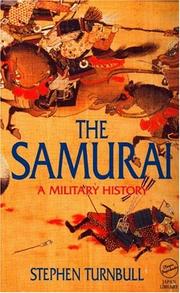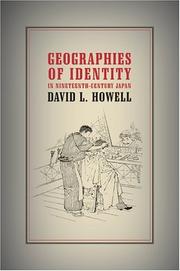| Listing 1 - 8 of 8 |
Sort by
|
Book
ISBN: 147385041X 1473850398 9781473850392 9781473850408 1473850401 9781473850385 147385038X Year: 2016 Publisher: [Place of publication not identified]
Abstract | Keywords | Export | Availability | Bookmark
Book
ISBN: 0472127977 0472901931 1929280203 9781929280209 9780472127979 9780472901937 Year: 2002 Publisher: Ann Arbor, Michigan : University of Michigan Press,
Abstract | Keywords | Export | Availability | Bookmark
 Loading...
Loading...Choose an application
- Reference Manager
- EndNote
- RefWorks (Direct export to RefWorks)
Nowhere has there been a discussion of the confusion necessarily generated by the rapidity of the change or of the agony created in the lives of many whose attitudes, expectations, and even success depended on the continuance of now abolished institutions. Historians have ignored the settled conditions of most samurai and instead concentrated on the study of the minority of activist samurai leaders who, with the backing of only a few Han (feudal domains) sought to overthrow the old order and whose success in doing so has made the study of the modernization of Japan the prime concern of historians. The history of the Meiji period may have been an overall political and industrial success story, but for a fuller understanding of the conditions of that success it is also necessary to understand "what it was really like" for the members of the old elite to be estranged from the proponents of revolution and what many members did to assure their own social and psychological position in a world they had not expected. In this book the author attempts to show that the impact of the Meiji Restoration destroyed the meaningfulness of the Confucian doctrine for these declasse samurai. Through Christianity, the samurai attempted to revive their status in society by finding a doctrine that offered a meaningful path to power. But in doing so, they had to accept a new theory of social relations. Ultimately, as the convert's understanding of society became totally informed by the Christian doctrine, they accepted a transcendent authority that brought them into conflict with society about them. Therefore, to understand the development of a Christian opposition in Meiji society we must begin with the conversion experience itself.
Samurai --- Christian converts from confucianism --- Religious life. --- Japan --- History --- Converts from Confucianism --- Converts from Confucianism to Christianity --- Daimyo --- Christian converts from Confucianism --- Religious life
Book
ISBN: 9781440842702 9781440842719 144084271X 9798216141518 1440842701 Year: 2019 Publisher: Santa Barbara, California
Abstract | Keywords | Export | Availability | Bookmark
 Loading...
Loading...Choose an application
- Reference Manager
- EndNote
- RefWorks (Direct export to RefWorks)
The samurai were an aristocratic class of warriors who imposed and maintained peace in Japan for more than two centuries during the Tokugawa or Edo period, 1603-1868. While they maintained a monopoly on the legitimate use of violence, as a result of the peace the samurai themselves were transformed over time into an educated, cultured elite--one that remained fiercely proud of its military legacy and hyper-sensitive in defending their individual honor. This book provides detailed information about the samurai, beginning with a timeline and narrative historical overview of the samurai. This is followed by more than 100 alphabetically arranged entries on topics related to the samurai, such as ritual suicide, castles, weapons, housing, clothing, samurai women, and more. The entries cite works for further reading and often include sidebars linking the samurai to popular culture, tourist sites, and other information. A selection of primary source documents offers firsthand accounts from the era, and the volume closes with a selected, general bibliography.
Book
ISBN: 9004252665 9789004252660 9789004250109 9004250107 Year: 2014 Publisher: Leiden, Netherlands
Abstract | Keywords | Export | Availability | Bookmark
 Loading...
Loading...Choose an application
- Reference Manager
- EndNote
- RefWorks (Direct export to RefWorks)
In The Buddhist Goddess Marishiten , David A. Hall provides an in-depth exploration of the Buddhist cult of the warrior goddess Mārīcī; its evolution in India, China, and Japan; its texts and their audience; its rituals; and, finally, its efficacy as experienced by the Japanese warrior class—the bushi or samurai. In examining the psychological effects of these rituals on the Japanese warrior this volume moves beyond a narrowly focused examination of a religious cult. David A. Hall convincingly explains how these rituals aimed at preparing the warrior for combat and acted as an antidote for the toxicity of Post-Traumatic Stress Disorder (PTSD) when the warrior returned from the battlefield.
Samurai --- Daimyo --- Religious life --- Japan --- History. --- Marici, --- Marichi --- Mariji --- Marishi --- Marishi-ten --- Marishiten --- Molizhi --- Molizhi tian --- Molizhitian --- Mo li zhi tian --- Molizhitian Pusa --- 摩利支天 --- 摩利支天菩萨 --- Molizhitian pu sa --- Dipper Mother --- 斗母元君 --- Cult --- Marici

ISBN: 1138139998 1315073269 1134243626 9781134243624 9781315073262 1873410387 9781873410387 9781134243693 9781134243761 9781138139992 1134243693 Year: 1996 Publisher: Richmond, Surrey Japan Library
Abstract | Keywords | Export | Availability | Bookmark
 Loading...
Loading...Choose an application
- Reference Manager
- EndNote
- RefWorks (Direct export to RefWorks)
This is the authoritative reference on samurai life and warfare published outside of Japan.
Samurai --- Daimyo --- History. --- Japan --- History, Military. --- History --- J4202.10 --- J4880.40 --- J4880.60 --- Japan: Sociology and anthropology -- communities -- social classes and groups -- samurai, bushi --- Japan: Defense and military -- history -- Kamakura period, Yoshino (1185-1392) and Chūsei in general (1185-1600) --- Japan: Defense and military -- history -- Kinsei, Edo, Tokugawa period, early modern (1600-1867)
Book
ISBN: 9781501761645 1501761633 1501761625 1501761641 9781501761621 9781501761638 Year: 2022 Publisher: Ithaca, New York
Abstract | Keywords | Export | Availability | Bookmark
 Loading...
Loading...Choose an application
- Reference Manager
- EndNote
- RefWorks (Direct export to RefWorks)
"Addresses the impact of war and war memory during Japan's 'samurai age,' the period of time lasting from the establishment of the first shogunate as a result of the Genpei War (1180-1185) through the fall of the Tokugawa shogunate in 1868. The volume offers studies of 'cultural imprints,' defined as cultural traces holding specifically grounded historical meanings that persist through time, including literary works, artifacts, performing arts, and documents that were created by or about the samurai"-
Samurai --- Daimyo --- History. --- Japan --- History --- Historiography. --- Samurai culture, samurai in performing arts, samurai in premodern literature, Hideyoshi cultural legacy, medieval and Edo-period Japanese literature. --- al-Yābān --- Giappone --- Government of Japan --- Iapōnia --- I︠A︡ponii︠a︡ --- Japam --- Japani --- Japão --- Japon --- Japonia --- Japonsko --- Japonya --- Jih-pen --- Mư̄ang Yīpun --- Nihon --- Nihon-koku --- Nihonkoku --- Nippon --- Nippon-koku --- Nipponkoku --- Prathēt Yīpun --- Riben --- State of Japan --- Yābān --- Yapan --- Yīpun --- Zhāpān --- Япония --- اليابان --- يابان --- 日本 --- 日本国 --- Jepun --- Yapon --- Yapon Ulus --- I︠A︡pon --- Япон --- I︠A︡pon Uls --- Япон Улс

ISBN: 1282759299 9786612759291 0520930878 1597346322 9780520930872 9781597346320 9780520240858 0520240855 9781282759299 6612759291 Year: 2005 Publisher: Berkeley, Calif. University of California Press
Abstract | Keywords | Export | Availability | Bookmark
 Loading...
Loading...Choose an application
- Reference Manager
- EndNote
- RefWorks (Direct export to RefWorks)
In this pioneering study, David L. Howell looks beneath the surface structures of the Japanese state to reveal the mechanism by which markers of polity, status, and civilization came together over the divide of the Meiji Restoration of 1868. Howell illustrates how a short roster of malleable, explicitly superficial customs-hairstyle, clothing, and personal names- served to distinguish the "civilized" realm of the Japanese from the "barbarian" realm of the Ainu in the Tokugawa era. Within the core polity, moreover, these same customs distinguished members of different social status groups from one another, such as samurai warriors from commoners, and commoners from outcasts.
Ainu --- Ethnic identity. --- Japan --- al-Yābān --- Giappone --- Government of Japan --- Iapōnia --- I︠A︡ponii︠a︡ --- Japam --- Japani --- Japão --- Japon --- Japonia --- Japonsko --- Japonya --- Jih-pen --- Mư̄ang Yīpun --- Nihon --- Nihon-koku --- Nihonkoku --- Nippon --- Nippon-koku --- Nipponkoku --- Prathēt Yīpun --- Riben --- State of Japan --- Yābān --- Yapan --- Yīpun --- Zhāpān --- Япония --- اليابان --- يابان --- 日本 --- 日本国 --- Social conditions --- Civilization --- Jepun --- Yapon --- Yapon Ulus --- I︠A︡pon --- Япон --- I︠A︡pon Uls --- Япон Улс --- ainu culture. --- ainu. --- anthropology. --- assimilation. --- barbarian. --- barbarism. --- bunka. --- buraku. --- burakumin. --- burakushi. --- civilization. --- class. --- commoner. --- cultural difference. --- custom. --- daimyo. --- early modern japan. --- east asia. --- folk practices. --- folk tradition. --- history. --- japan. --- japanese history. --- meiji restoration. --- nation. --- national identity. --- nonfiction. --- othering. --- outcast. --- peasant. --- polity. --- race. --- samurai. --- social status. --- status. --- tokugawa.
Book
ISBN: 1501706640 1501706098 9781501706646 9781501706097 9781501703096 1501703099 Year: 2016 Publisher: Ithaca
Abstract | Keywords | Export | Availability | Bookmark
 Loading...
Loading...Choose an application
- Reference Manager
- EndNote
- RefWorks (Direct export to RefWorks)
In Samurai to Soldier, D. Colin Jaundrill rewrites the military history of nineteenth-century Japan. In fifty years spanning the collapse of the Tokugawa shogunate and the rise of the Meiji nation-state, conscripts supplanted warriors as Japan's principal arms-bearers. The most common version of this story suggests that the Meiji institution of compulsory military service was the foundation of Japan's efforts to save itself from the imperial ambitions of the West and set the country on the path to great power status. Jaundrill argues, to the contrary, that the conscript army of the Meiji period was the culmination-and not the beginning-of a long process of experimentation with military organization and technology.Jaundrill traces the radical changes to Japanese military institutions, as well as the on-field consequences of military reforms in his accounts of the Boshin War (1868-1869) and the Satsuma Rebellions of 1877. He shows how pre-1868 developments laid the foundations for the army that would secure Japan's Asian empire.
Samurai --- Draft --- Daimyo --- Compulsory military service --- Conscription, Military --- Military conscription --- Military draft --- Military service, Compulsory --- Military training, Universal --- Selective service --- Service, Compulsory military --- Universal military training --- National service --- Recruiting and enlistment --- Conscientious objectors --- History --- Japan --- al-Yābān --- Giappone --- Government of Japan --- Iapōnia --- I︠A︡ponii︠a︡ --- Japam --- Japani --- Japão --- Japon --- Japonia --- Japonsko --- Japonya --- Jih-pen --- Mư̄ang Yīpun --- Nihon --- Nihon-koku --- Nihonkoku --- Nippon --- Nippon-koku --- Nipponkoku --- Prathēt Yīpun --- Riben --- State of Japan --- Yābān --- Yapan --- Yīpun --- Zhāpān --- Япония --- اليابان --- يابان --- 日本 --- 日本国 --- Armed Forces --- Recuiting, enlistment, etc. --- History, Military --- J4880.70 --- J3373 --- Japan: Defense and military -- history -- Kindai (1850s- ), bakumatsu, Meiji, Taishō --- Japan: History -- Kindai, modern -- Meiji period (1868-1912) -- modernization and innovation --- Jepun --- Yapon --- Yapon Ulus --- I︠A︡pon --- Япон --- I︠A︡pon Uls --- Япон Улс
| Listing 1 - 8 of 8 |
Sort by
|

 Search
Search Feedback
Feedback About UniCat
About UniCat  Help
Help News
News